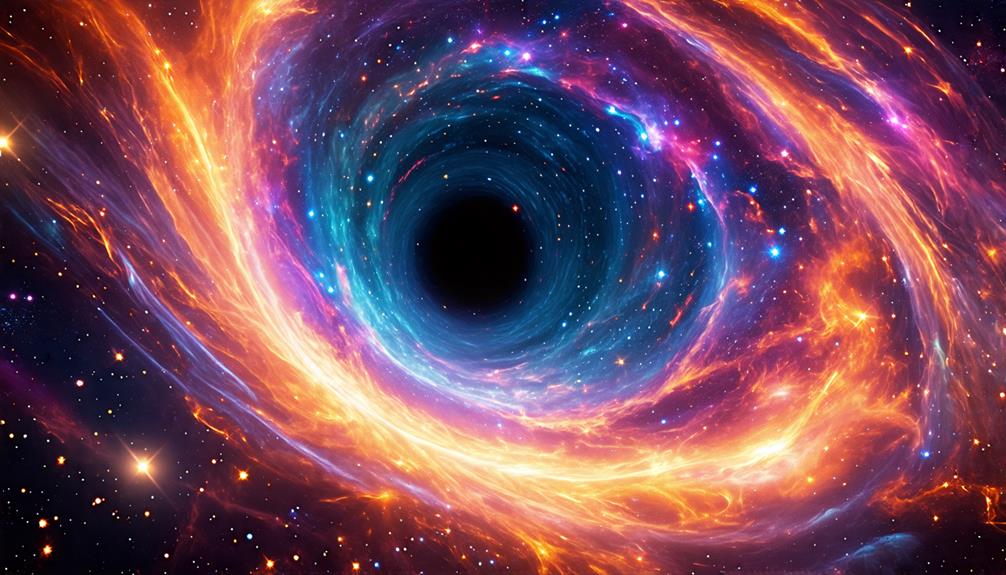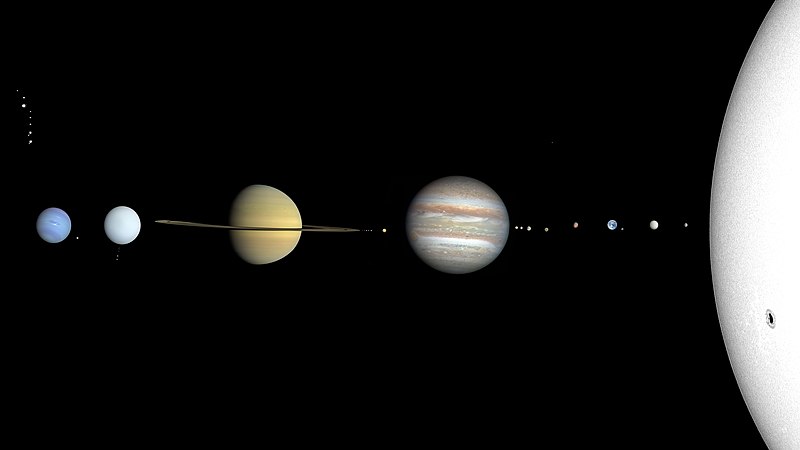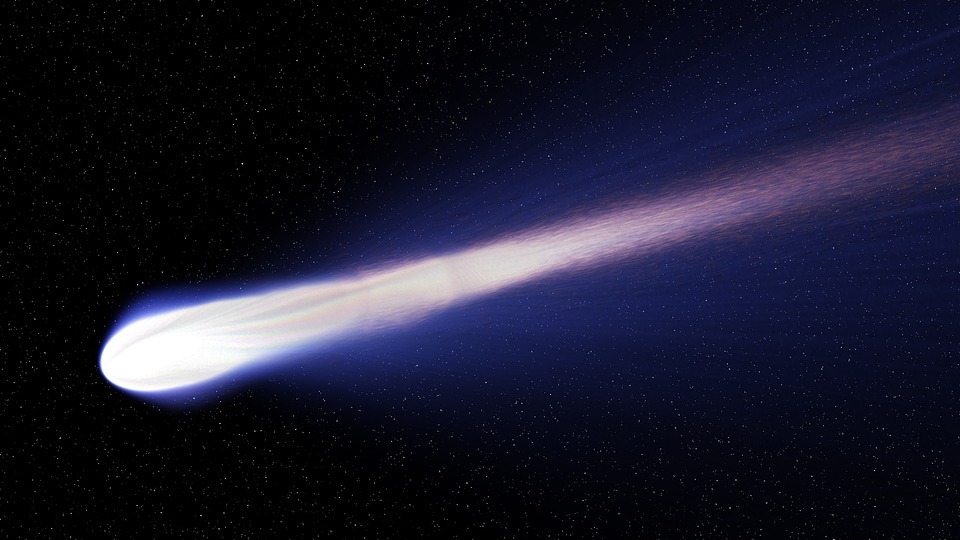What Gas Giant Moons Could Support Life?
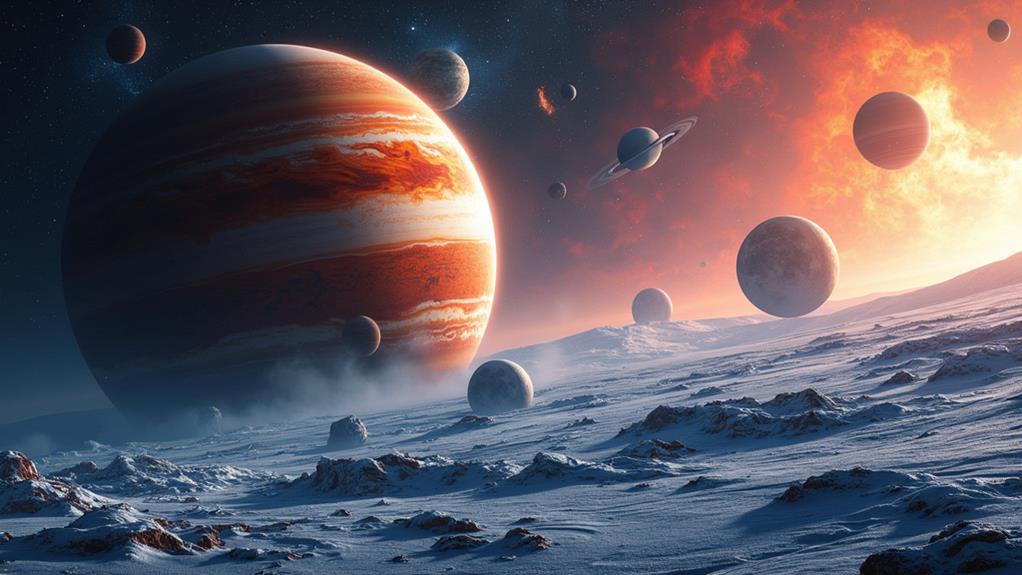
You might be curious about which gas giant moons could support life. Europa, Enceladus, Titan, Ganymede, and Callisto top the list. They're believed to have subsurface oceans beneath their icy crusts, kept warm by tidal heating. Europa's saltwater ocean, Enceladus' geysers, Titan's dense atmosphere and likely water-ammonia ocean, Ganymede's magnetic field, and Callisto's low radiation exposure all hint at potential habitability. These moons present intriguing possibilities for life, and there's more fascinating information awaiting you about each of them and the missions aiming to investigate these worlds.
Key Takeaways
- Europa likely has a subsurface ocean beneath its icy crust, sustained by tidal heating.
- Enceladus features active geysers and a subsurface ocean in contact with a rocky core.
- Titan has a dense atmosphere and a possible subsurface ocean of water-ammonia mix.
- Ganymede shows evidence of a magnetic field and a layered subsurface ocean.
- Callisto may possess subsurface water, with low radiation exposure preserving potential habitability.
Overview of Habitability
When considering the habitability of moons orbiting gas giants, it's crucial to focus on the presence of liquid water, energy sources, and fundamental chemical ingredients. Moons like Europa, Enceladus, Titan, Ganymede, and Callisto stand out as strong candidates for habitability. These celestial bodies are believed to harbor subsurface oceans, where liquid water is kept in a stable state beneath icy crusts. This liquid water is a critical factor for any habitable environment.
The presence of energy sources, such as tidal heating, plays a significant role in maintaining these subsurface oceans. Tidal heating results from the gravitational pull between the moons and their host gas giants, generating internal friction and heat. This process not only keeps water in a liquid state but also drives geological activity, potentially creating stable and life-supporting environments.
Additionally, the availability of crucial chemical elements like carbon, hydrogen, nitrogen, and oxygen further improves the habitability potential of these moons. Research underscores that moons with a minimum mass of around 0.1 solar masses can sustain magnetic fields and long-lived atmospheres, offering protection from harmful radiation and maintaining surface stability. These unique environments expand the scope of astrobiology and the search for extraterrestrial life.
Liquid Water Evidence
Compelling evidence underscores the existence of liquid water on several gas giant moons, pointing to their potential habitability. Europa, for instance, likely has a salty subsurface ocean beneath its icy crust, which is approximately 60 miles deep. This vast liquid water reservoir places Europa within the habitable zones of interest for astrobiologists.
Similarly, Enceladus displays remarkable signs of a subsurface ocean. Geysers on its surface eject water vapor and ice particles, indicating that this liquid water ocean is in contact with a rocky core, creating conditions that could support life.
Ganymede, the largest moon in the Solar System, also presents intriguing possibilities. It's believed to have a layered ocean beneath a thick ice shell. Such a structure could offer environments where life-sustaining conditions exist.
Titan, Saturn's largest moon, adds a unique twist to the story. Its subsurface ocean, likely a mix of water and ammonia, lies beneath a dense icy crust. This mixture could facilitate prebiotic chemistry, enhancing its potential as a habitable zone.
Lastly, Callisto's geological features and low radiation exposure suggest it may possess subsurface water as well, furthering its candidacy for habitability. These moons highlight the exciting potential for life beyond Earth within our Solar System.
Tidal Heating Impact
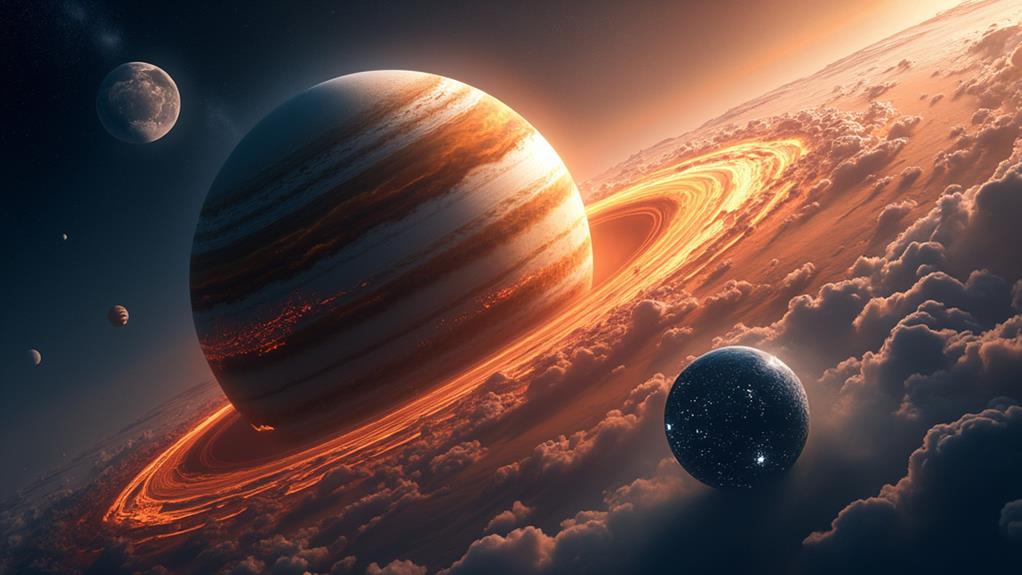
Understanding the presence of liquid water on these moons leads us to contemplate another vital factor: tidal heating. Tidal heating is fundamental for gas giant moons because the immense gravitational pull from their parent planets generates internal friction. This friction is pivotal for maintaining subsurface oceans and driving geological activity.
Moons with orbital periods less than 45-60 days experience stronger tidal forces, which can amplify heating and create more stable environments for potential life. For instance, Europa and Enceladus exhibit significant tidal heating, directly contributing to their subsurface oceans and making them prime candidates for habitability.
The amount of tidal heating a moon experiences depends on its eccentric orbit. An eccentric orbit causes varying levels of internal stress and heat generation, which can increase the moon's internal temperature. This process not only supports the presence of liquid water but also facilitates nutrient cycling and critical chemical reactions in subsurface oceans.
Notable Moons in Solar System
Exploring the notable moons in our solar system reveals fascinating prospects for life beyond Earth. Europa, a moon orbiting Jupiter, stands out with its suspected subsurface ocean beneath an icy crust. This hidden ocean could harbor habitable conditions, making Europa a prime candidate for extraterrestrial life.
Enceladus, a moon orbiting Saturn, offers another intriguing possibility. Its active geysers spew water vapor and ice particles, pointing to a subsurface ocean rich in organic compounds and salts. These features make Enceladus a compelling target in the search for life.
Titan, also orbiting Saturn, is unique with its dense nitrogen atmosphere and surface lakes of liquid methane and ethane. It likely harbors a subsurface ocean as well, providing environments where prebiotic chemistry might occur.
Ganymede, the largest moon in the solar system, shows signs of a magnetic field, suggesting a subsurface ocean. Its geological history indicates dynamic processes that could support habitable conditions.
Lastly, Callisto, another of Jupiter's moons, presents a more stable environment with its heavily cratered surface and minimal tidal heating. This stability might preserve primordial conditions favorable for life, making Callisto another moon worth considering.
Potential Exomoon Candidates
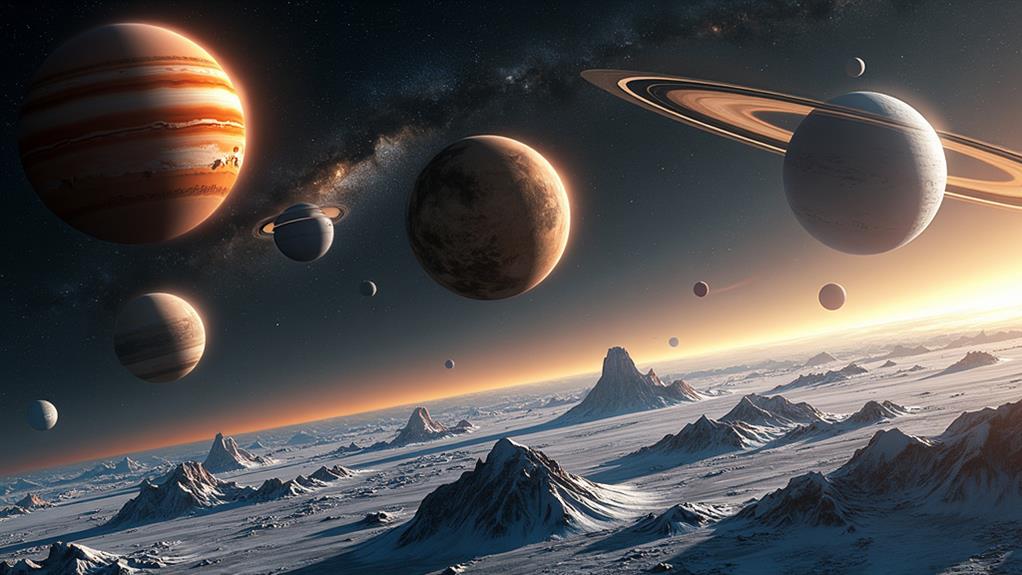
The search for life doesn't stop within our solar system but extends to potential exomoon candidates orbiting distant gas giants. Exomoons in the habitable zones of their systems, like those identified by the Kepler spacecraft, could offer the right conditions for potential life. These moons might harbor liquid water and maintain stable environments essential for sustaining life.
Consider the following intriguing points about exomoons:
- Dual Energy Sources: These moons benefit from both their host star and the gas giant, possibly creating diverse habitats.
- Mass Requirements: For a moon to be habitable, researchers suggest it should have a mass around 0.1M☉ for generating magnetic fields and 0.23M☉ for tectonic activity.
- Potential Hosts: Gas giants like TZ343-B could support Earth-like moons with the necessary conditions for life.
- Current Limitations: No exomoons have been directly identified yet, but studies are ongoing to detect them and assess their habitability.
The potential for finding life on exomoons is immense, and understanding their environments could redefine our search for extraterrestrial life. Advanced observational techniques and future telescopes will be vital for uncovering these moons and evaluating their potential to host life.
Current Research Methods
In regard to studying gas giant moons, current research methods are making strides with a combination of transit and radial velocity techniques to detect exoplanets and near-infrared spectroscopy to analyze the surface compositions of potential moons. These advanced observational techniques are vital, given that exomoons are smaller and more challenging to detect than their host gas giants. By observing the subtle dimming of a star (transit) or the star's wobble (radial velocity), you can infer the presence of these distant worlds.
Data from the Kepler spacecraft has laid the groundwork for future moon detection. It identified numerous gas giants in habitable zones, suggesting these regions could host Earth-like moons. Near-infrared spectroscopy further helps you comprehend the composition and potential habitability of these moons by analyzing their reflected light.
Ongoing missions, like those studying Europa and Titan in our solar system, provide valuable insights. These missions assess their habitability and potential for supporting life, offering models that can be applied to exomoons. International collaboration is fundamental to improve detection technologies and refine models of habitability. By pooling resources and expertise, you can better investigate the possibilities of life on gas giant moons.
Future Exploration Missions
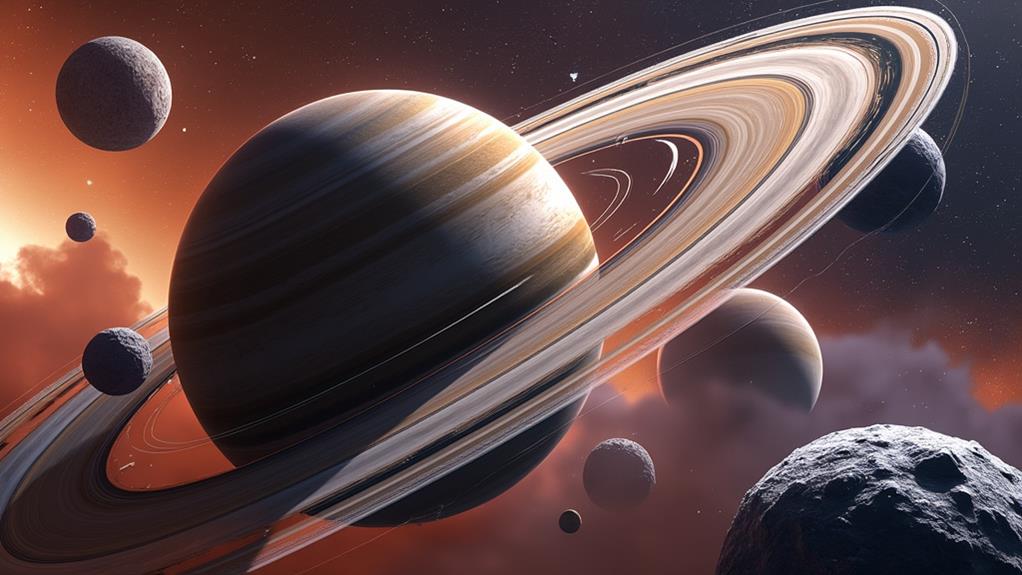
Anticipation for future investigation missions is high as they're set to unveil the secrets of gas giant moons and their potential to harbor life. You're likely excited to hear about NASA's Europa Clipper mission, scheduled for launch in the 2020s. This mission aims to plunge deep into Europa's subsurface ocean to assess its habitability by analyzing its surface and subsurface compositions. Another thrilling mission on the horizon is Dragonfly, which will examine Titan using a rotary drone to analyze diverse environments, including its hydrocarbon lakes and subsurface ocean, for prebiotic chemistry.
These missions are essential for understanding the potential of icy moons within the habitable zone of gas giants. Advancements in detection technologies are also playing a significant role in identifying exomoons around distant gas giants, improving our knowledge of their habitability potential.
- Europa Clipper: Investigates Europa's subsurface ocean.
- Dragonfly: Examines Titan with a rotary drone.
- Detection Technologies: Advances aid in identifying exomoons.
- Collaborative Efforts: International research initiatives improve exploration.
Future missions will gather data on the chemical compositions and geological activities of moons like Enceladus and Ganymede, revealing their capacity to support life.
Frequently Asked Questions
Are There Any Moons That Can Support Life?
You might wonder if any moons can support life. Look at Europa and Enceladus; their subsurface oceans and tidal heating make them prime candidates. Extremophile organisms, which thrive in extreme conditions, could potentially exist there. Titan's thick atmosphere and liquid methane lakes also offer intriguing possibilities. Ganymede, with its magnetic field and suspected ocean, and Callisto, with minimal radiation exposure, are promising too. Even Triton shows potential due to its unique conditions.
What Are the Possible Habitable Moons?
You're asking about the possible habitable moons. Europa, Enceladus, and Titan are your top ocean worlds. They have subsurface oceans that might support extremophile organisms. Europa's 60-mile deep ocean, Enceladus's geysers, and Titan's liquid methane lakes are key features. Ganymede also shows promise with its magnetic field and geological activity. These moons offer intriguing environments where life could potentially thrive, making them prime targets for exploration.
Could Life Survive on a Gas Giant?
You wonder if life could survive on a gas giant. The extreme conditions, like high pressure and turbulent storms, make it challenging. However, some scientists speculate that microbial survival might be possible in the upper layers of the atmosphere, where conditions are less harsh. The atmospheric composition, rich in hydrogen, helium, and other gases, could potentially support unique life forms, although it's a tough environment for Earth-like organisms.
Could Ganymede Support Life?
Imagine diving beneath Ganymede's icy crust into its subsurface ocean. You'd find a world teeming with possibilities. Ganymede's atmosphere is thin, but its magnetic field acts like a shield, protecting life from radiation. Beneath the surface, the subsurface ocean may interact with a rocky seabed, creating a cocktail of minerals and energy sources. These conditions suggest that Ganymede could potentially support life, making it a fascinating target for future exploration.

